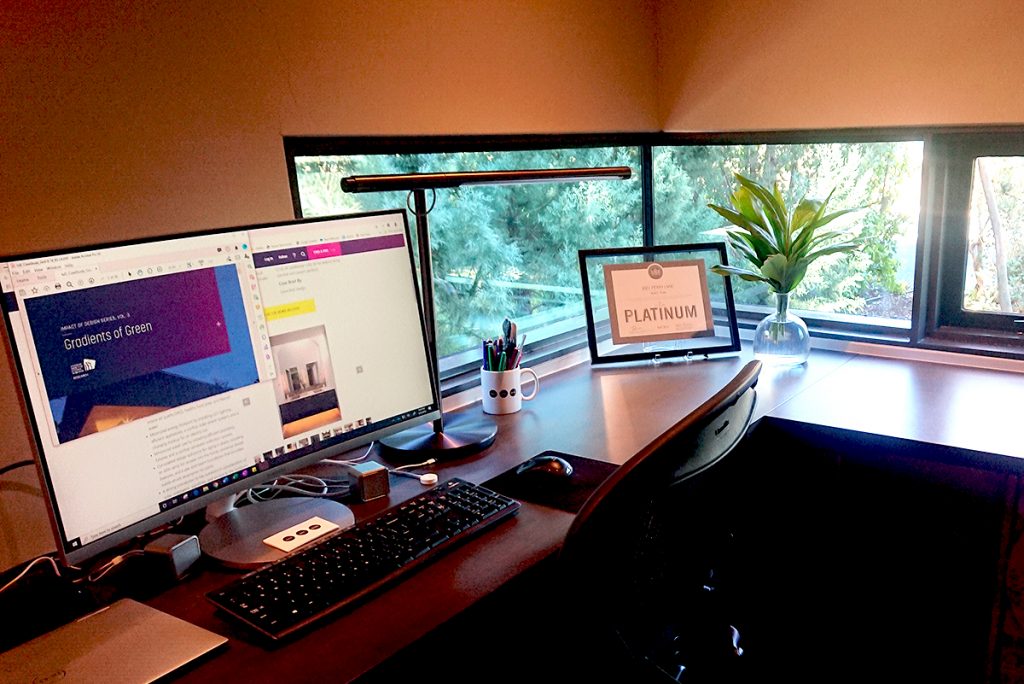Before working from home became more normal, many of us enjoyed our commute as a way to gradually transition from our home persona to our work persona. As the next normal emerges, and we don’t know how long working from home will be a requirement, re-creating that move from home-to-work-to-home is a challenge that architects and those of us designing our own homes need to consider.
If you have the outside space, putting a home office into a separate building in your garden is ideal. However, if you need to work and mind your kids at the same time, then a separate garden room isn’t really going to be much help. As always, the size of your home will determine whether your home office is a cockpit or fold-out desk

in your living room, a guest bedroom that can double-up as an office, a small bedroom nobody wants that can be converted into an office, or a room that is designed specifically as a home office. These days, the real challenge can be carving out enough space for two people to work from home so combing a fold-out desk with a guest room cum office may be your best option. Either way, avoiding the kitchen or dinning room table is strongly recommended for anything other than occasional use for work.
Whatever space you have available, here are some practical tips from the architect team at Opoplan:
Carving out a space for your home office, that allows you to concentrate on work without being distracted by other family activity and with enough space to stand up and stretch every once in a while, or even enough space for a stand-up desk is worth the upheaval within the house. Think about how you can protect your office space at home from becoming another drop zone within the house or worse, a hang-out area for your kids or teens.
Where you position your screen/monitor is probably the most important thing to consider. The recommendation is that the screen should be at eye level and an arms-length away from your face and your keyboard should be at a level where your wrist is below your elbow. This is the reason why converting your laptop to be more like a desktop by raising the screen to eye level is a good idea if the home office arrangement is going to be used more than occasionally. Laptop stands can be bought online for as little as $10 and adding a wireless keyboard and mouse makes life easier. A stand for your phone instead of laying it on the desk is better for your neck and again, just makes life that little bit easier. Investing in a set of headphones, for those inevitable zoom calls, that also work with your phone gives you maximum flexibility.
Plug sockets and windows play a huge part in how comfortably you can work in your home office. Placing your desk or workspace close to sockets means you are less likely to need unsightly and often unsafe extension leads crossing your floor space, while sunlight coming into any room lifts our mood. The issue with sunlight is that it can cause glare, which in simple terms is contrast that hurts your eyes, so, if your screen catches reflections from a brighter window for example, your eyes don’t know what to focus on and this leads to tired and itchy eyes. Consider how you angle your desk and your screen to avoid direct sunlight and consider blinds on the window that will allow light to come into the room without causing glare.

Your chosen desk is crucial too and ideally, to avoid back and neck strain, a work desk and adjustable work chair is the best option. Your desk needs to be big enough to handle your PC and/or laptop, a second screen and keyboard/mouse plus your phone, coffee cup and any notebook or paperwork that you might use but at the same time make sure it is not so big that it attracts clutter, and while your work chair doesn’t have to be a large executive chair, simply being able to adjust its height will make a difference.
Office buildings generally have lots of greenery and plants. This is because plants are mood enhancing and having a view outside over your garden or placing a plant close to your workspace at home is a good tip to take home from the office.
Finally, at floor level, make sure that your work chair won’t damage your flooring, particularly important if you have solid wood or tiled floors, and you certainly don’t want to damage a good carpet with a wheely chair. Hardwearing rugs are a good investment to protect home floors.
If you are setting up your home office in a guest bedroom, having either the bed or your office in a fold-away cabinet makes the most of your space and converting the closet to combine shelves for your files as well as your clothes is really worth considering if your home office is going to be a medium to long term arrangement.
Some people have come up with unique arrangements in their home office; in my own case, I have my treadmill beside my desk so I have no excuse not to take a desk break for 5 minutes every hour and just hop on the treadmill for a quick stroll. If you’ve got your own unique home office arrangement, share your pictures with us on our social channels #uniquehomeoffice.
Lastly, if you are thinking about a separate home office unit Opoplan can help you understand what would fit in your yard or garden. Start our design brief and select the ‘office pod’ option.
If you’d like to receive our weekly Architect Design Tips by email, register here



